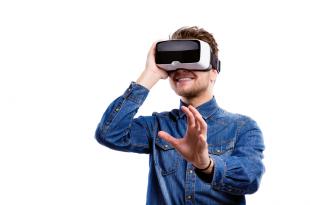When some people think of virtual reality (VR) they may envision the super intense gamer with a huge helmet and goggles who is synced into world full of zombies and other strange creatures. However, virtual reality is way more than just helmets and zombies. According to Merriam-Webster Dictionary, it is actually a 3D image or environment that can be interacted with in a seemingly real or physical way. Helmets and goggles are used, but so are screens, fitted gloves, and sensors.
Although it can be used for gaming, VR can also be used for educational purposes. Here are three reasons why virtual reality elearning courses will change the way students think and is sure to be a hot commodity in the elearning world.
1. Remembering what you did vs. what you read/heard:
At this point I am sure we have all taken some sort of driving course where we had to read a booklet and pass the exam. Although I am sure we all passed, (hopefully), how much of the book do you truly remember? Actually, here’s a better scenario for you: say you are about to parallel park, something you openly despise, and you need a quick refresher. Will you remember what your driver instructor told you years ago or will you remember the time your Dad taught you to park and you accidentally dinged the car in front of you (thankfully, it was just your brother’s old Honda)?
Now let’s relate this to virtual reality and elearning. If a student is learning about chemical lab safety which do you think they will remember first? The passage from their textbook or when they took a virtual reality elearning course where they actually handled hazardous materials to prevent accidents from happening? Sometimes, if not most times, people remember what they experienced – not what they read or heard.
2. Learning on-the-go
In today’s society, adolescents are on their phones 24/7, so why not have them use their favorite devices to learn? Unfortunately, having a textbook with you all day is not the norm, the most convenient, or the most technologically advanced thing to do. But one technological advancement we can utilize is the new virtual reality device called Google Cardboard. This device is lightweight and cheap to produce. It includes cardboard, optical lenses, magnets, and even clamps to keep your precious smartphone in place. Here’s another scenario: if students have to choose between lugging around a five pound textbook or their virtual reality- compatible smartphone (and the Google Cardboard) to view and interact with their readily available elearning course, which do you think they would prefer? May be a tight race… but my bet is that the smartphone would be the victor.
3. Broadens Horizons
One of the most beneficial features with virtual reality in elearning is that it includes endless possibilities. Let’s go back to your first day of college, and your professor is referencing all of these terms (he thinks) you are familiar with. It can be easy to gloss over the topics and self-consciously pray you find a tutorial later to help you understand. But just imagine if that professor changed his teaching methods. Instead of going over these terms in the classroom he could simply assign a virtual reality elearning course to his students instead. So that student can now interact with a new reality and potentially have their interest sparked. This student now not only understands the topic more but has also developed an interest in the subject and is considering majoring in it. Granted, we may be jumping through a few hoops here – but that is the point. By having an ample amount of virtual reality elearning courses readily available to students, they will be able to broaden their horizons by simply putting on a helmet and goggles.
As for now, virtual reality elearning courses are still in the works. But do not be surprised if in the near future your 6th grader comes home with a school supply list that includes virtual reality headphones and goggles.






